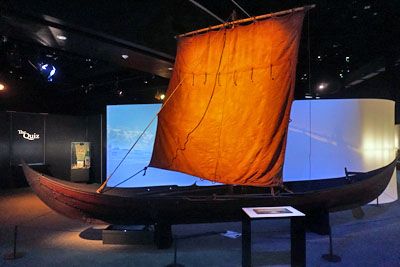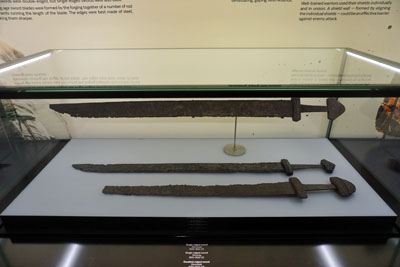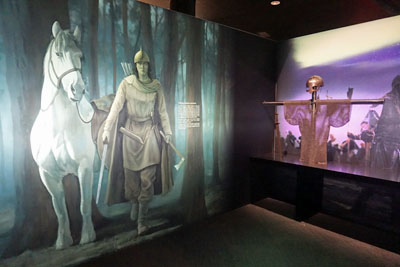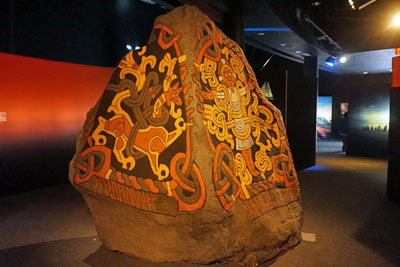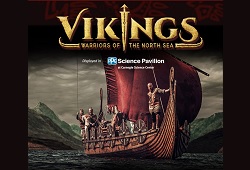
Odin, the king of Asgard. Frigg, Odin’s wife, goddess of marriage and motherhood. The Mighty Thor, god of thunder. Loki, his mischievous adopted brother. The Valkyries, armed female warriors who guided those slain in battle to Valhalla.
The Viking gods and goddesses from the first millennium are still well-known in contemporary times, thanks in part to the Marvel Universe of both comic books and blockbuster motion pictures that feature many of them alongside such contemporary superheroes as Captain America and Iron Man.
There is more to Viking culture and history, however, than a collection of gods transformed into modern day superheroes. A seafaring society from Scandinavia, the Vikings rose to prominence in the eighth century and continued to influence and flourish well into the eleventh century.
In 1807, the National Museum of Denmark was tasked with preserving the culture of the region, which inevitably included the Vikings. In February 2023, many of the artifacts collected found their way to the Carnegie Science Center in Pittsburgh, Pennsylvania, part of a traveling exhibit simply entitled Vikings: Warriors of the North Sea.
While the gods and goddesses of Asgard were indeed represented, the exhibit focused on Viking culture as whole – from shipbuilding to commerce, fierce warriors to rural farmers – offering a diverse and insightful overview of the Viking Age.
That age coincided with an unstable Europe yet to be united into the nations of today, instead collected into a series of small kingdoms ruled by rival kings. With a ferocity in battle and unrivaled skills when it came to swords, spears, and shields, the Vikings were able to pillage and conquer many of these kingdoms, especially those located along the coastline.
Since Scandinavia contained an abundance of timber and iron, meanwhile, the Vikings were able to establish a trade network that stretched through Byzantium, Russia, and into the Far East. Situations were thus ripe for the Vikings to leave their mark, and they did just that throughout the known and unknown worlds of the times.
Scandinavia has long coastlines and numerous inland lakes and waterways, meaning that ships were a necessity for those living in the region. “Without ships, there would be no Vikings!” the Warriors of the North Sea exhibit exclaims. Scandinavian shipbuilders were adept at finding the right trees and designs to perfect Viking ships and allow them to travel beyond Scandinavia into Europe, Greenland, and even North America.
The Vikings: Warriors of the North Sea exhibit features a reconstruction of a small boat that was discovered inside a “grave chamber” on a larger ship in Gokstad, Norway. The displayed craft was built by the Viking Ship Museum in Norway with the same tools, materials, and techniques utilized by Vikings in the year 895 CE. “An oak tree measuring 0.91 metre in diameter was radially cleaved into halves, quarters, eights, and finally shaped into planks using replicas of Viking tools, such as axes, spoon drills or planes,” the exhibit explains.
How Vikings were able to travel across seas and oceans without any maps is still a mystery, but it is assumed that they mastered using their senses to assist with their travels. “They looked for distinctive land formations, listened for the sounds of birds or other land animals, smelled the salt air and, when it seemed less salty, tasted the water for hints of fresh water that they could follow inland,” Warriors of the North Sea notes. This uncanny ability allowed the Vikings to not only explore regions far from Scandinavia but plunder, pillage, and trade with them as well.
It is for their plundering and pillaging that the Vikings are arguably most remembered, as Vikings were amongst the fiercest warriors of the time period. Bearing arms was both a right and duty, and men were even required by law to own a shield, spear, and sword or axe. Although not as militarily skilled as warriors from other nations, the Vikings relied on speed and mobility, transporting their warriors by ship and then having them sneak into coastal villages to plunder. They were back on the ship and sailing away before local forces could mount a counterattack.
It wasn’t just Viking men who were warriors but Viking women as well. Vikings: Warriors of the North Sea notes that genetic analysis of a body buried with Viking weapons in the tenth century revealed the warrior to be female. The exhibit also mentions that many Icelandic sagas contain “shield maidens” who wielded weapons and fought in battle.
The Viking Age coincided with the rise of Christianity throughout Europe, and the extensive travels of the Vikings inevitably put them in contact with Christian practices. As one of the last pagan societies in the region, it was only a matter of time before the Vikings likewise embraced the flourishing religion. Although considered a political decision to pre-empt challengers to the throne as opposed to genuine spiritual conviction, King Harald proclaimed Christianity as the official religion of the Vikings in 965 CE.
The town of Jelling in Denmark was the centerpiece of Harald’s rule, and a large stone – a replica of which is part of the Viking: Warriors of the North Sea exhibit – proclaims the king’s conversion to Christianity for not only himself but all of Denmark as well.
According to Viking legend, the final battle of Ragnarök will result in all gods, humans, animals, and supernatural beings perishing in fire and ice, returning the universe to the nothingness from which it originated. While Ragnarök has yet to occur, the Viking Age inevitably came to an end nonetheless, leaving only legends, myths, and artifacts behind. Vikings: Warriors of the North Sea transports visitors back to the days when Vikings were still feared, offering a better understanding of their culture in the process.
Anthony Letizia (March 26, 2023)
